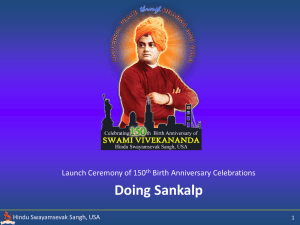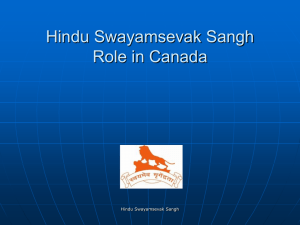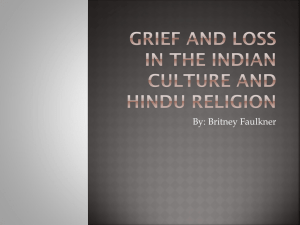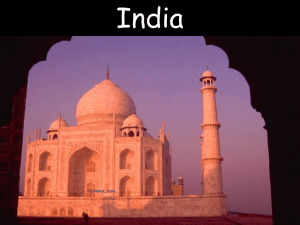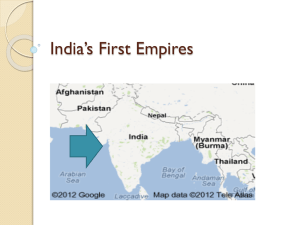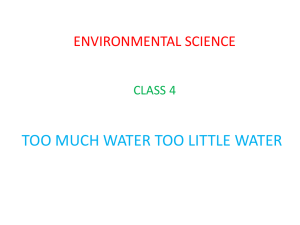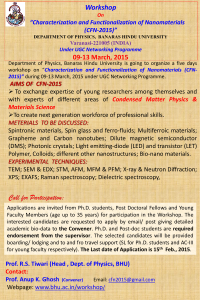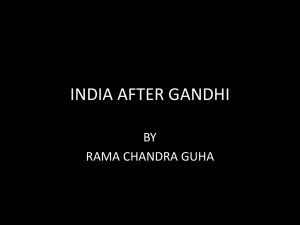HinduContributions_HSC
advertisement
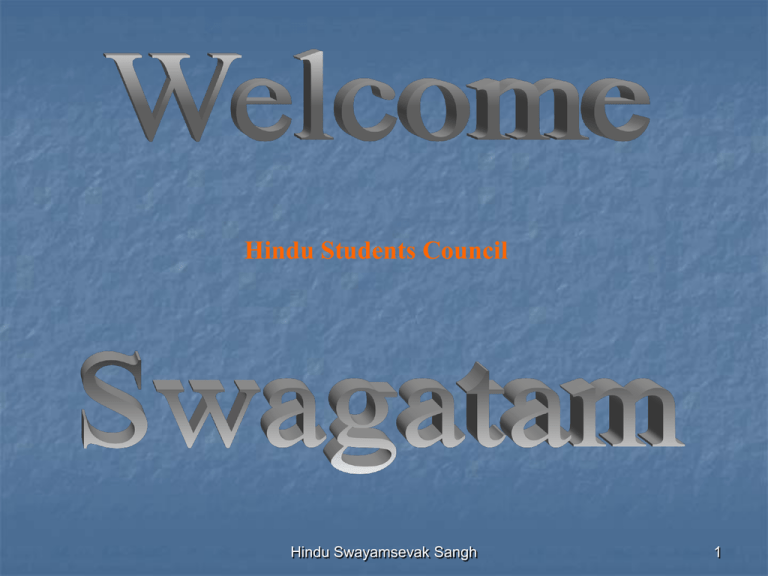
Hindu Students Council Hindu Swayamsevak Sangh 1 Hindu Contributions to Humanity Beginning of Hindu Scientific Thought Concept of Time and Astronomy Physics, Chemistry, Metallurgy Mathematics Language and Grammar Science and Education Hindu Swayamsevak Sangh 2 Hindu Contributions to Humanity Engineering (Ship Building, Navigation) Philosophy and Yoga Ayurveda and Surgery Hindu Swayamsevak Sangh 3 Beginning of Hindu Scientific Thought Hindu thought and systems can be traced back to at least 10,000 years The oldest book known to mankind is the RgVed. Knowledge was developed over thousands of years by various Rishis, philosophers, poets and engineers at well established schools Hindu Swayamsevak Sangh 4 Chronology of the pre-historic period of India 7000-4000 BC Vedic Age 3750 BC End of Rig Vedic Age 3000 BC End of Ramayana-Mahabharat Period 3000-2000 BC Development of Saraswati-Sindhu (Indus) Civilization 2200-1900 BC Decline of Indus and Saraswati Civilization 2000-1500 BC Mahaveer, Buddha, Chanakya, Maurya 1400-250 BC Shankaracharya, Gupta Hindu Swayamsevak Sangh 5 Chatur Dasha Vidya or 14 Books of Knowledge 4 Vedas Rig 6 Vedangas Siksha (Phonetics) Vyakarana (Grammer) Yajur Sama Atharva Chhandas (Metres) Niruktam (Etymology) Jyotisham (Astronomy) Kalpam (ceremonies) 4 Upa Vedas 4 Upangas Ayurveda (Charak Samhita) Mimamsa (Jaimini) Dhanurveda (Vishwamitra) Nyaya (Rishi Gautam) Gandharva Veda (Bharat Muni) Puranas (Ved Vyas) Stapathya Veda & Artha Shastra (Bhrugu Ved Vyas) Dharma Shastras (Manu, Parashar, Yajnavalkya etc) Hindu Swayamsevak Sangh 6 References Mahabharat, Ramayan, Purana Texts from various Rishi traditions Srimad Bhagavata The Dharmasastra Chanakya Neeti Hindu Swayamsevak Sangh 7 Concept of Time There were very advanced Hindu astronomers in 600 B.C. The Vedas contain an account of the dimensions of Earth, Sun, Moon, Planets and Galaxies. Emmelin Plunret, in “Calendars and Constellation” Hindu Swayamsevak Sangh 8 Vedic Astronomy Highest and Smallest Units of Time Maha Kalpa or Brahma Ayu is the largest Unit of Time = 311,040,000,000,000 solar years. TRUTI is the smallest Unit of Time = 33,750th part of a Second Hindu Swayamsevak Sangh 9 Vedic Astronomy Small Units of Time TRUTI smallest unit of TIME = 33,750th fraction of a second 100 Truti = 1 Tatpara 45 Tatpara = 1 Nimesha 3 Nimesh = 1 Vipala 60 Vipalas = 1 Pala 60 Palas = 1 Ghatika Divisions of a Day 60 Ghatikas = 1 Ahoratra = 1 Day * 10 Vipalas = 1 Prana = 4 seconds *2 Ghatikas = 1 Muhurta *2.5 Ghatikas = 1 Hora = 1 Hour Hindu Swayamsevak Sangh 10 Vedic Astronomy Medium Units of Time 7 Divas = 1 Saptah 15 Divas = 1 Paksha 2 Paksha = 1 Maas 2 Maas = 1 Ritu 4 Maas = 1 Chatur Maas 2 Paksas- Shukla Krishna 6 Ritus - Vasant, Gresshma, - Varsha, Sharad, - Hemant, Sishir 6 Maas = 1 Ayana 12 Maas = 1 Varsha 2 Ayanas - Uttarayana Dakshinayana Hindu Swayamsevak Sangh 11 Measurement of Time Bhaskaracharya Surya Siddhanta Earth to orbit the sun = 365.2587 56484 days 365.2596 days Modern accepted time Mahabharat (3138 B.C.) Eclipses, Meteors, Comets Hindu Swayamsevak Sangh 13 Physics, Chemistry, Metallurgy The Vedas contain not only religious ideas for a perfect life, but also facts which science has proved true. Electricity, radium, electronics, airship, all were known to the seers who founded the Vedas. Wheeler Wilcox, in “India, the land of the Vedas” Hindu Swayamsevak Sangh 14 Vedic Physics Measurement of Length 8 Paramanu = 1 Trasarenu 8 Trasarenu = 1 Renu 8 Renu = 1 Balagna 8 Balagna = 1 Likhya 8 Likhya = 1 Yuka 8 Yuka = 1 Yava 8 Yava = 1 Angula 24 Angula = 1 Hasta 4 Hasta = 1 Danda 2000 Danda = 1 Krosha 4 Krosha = 1 Yojana 1 Danada = 1 Metre 1Angula = 1.0416 cm Circumference of earth Sulva Sidhanta and Modern Science are same 4.02x107 Danda 4 X 107 Metre Hindu Swayamsevak Sangh 15 Vedic Physics Measurement of Mass 10 16 32 48 Krishnala = 1 Maasha Maasha = 1 Suvarna Pala (Gold Pala) Maasha = 1 Raupya Pala (Silver Pala) Maasha = 1 Lauha Pala (Iron Pala) Other forms of Weight were also in usage Hindu Swayamsevak Sangh 16 Vedic Physics Temperature (Linka) 1 Pralinka = 1 Padakakshya 4 Pada Kakshya = 1 Kakshya 6 Kakshya = 1 Linka = 0.885o C = 3.54o C = 21.24o C 113 Pada Kakshya = Boiling Pt of water = 100o C 101 Kakshya = Boiling Pt of Mercury = 357o C 50 Linka = Boiling Point of Gold = 1062o C * The temp between Freezing Pt of Water and Melting Pt of Gold is divided into 50 Linkas Hindu Swayamsevak Sangh 17 Vedic Physics Speed of Light 1300 AD Saayanaacharya PM of Vijayanagar Emperor Bukka I Speed of Light 2,202 Yojanas in half Nimesha = 186,536 miles per second West only in 17 century !! Hindu Swayamsevak Sangh 18 Mahabharata and Puranas Astonishing Details Air and Space Travel Embryo Transplantation Multiple Births from same Embryo Weapons of Mass Destruction Travel thru domains- Time is slowed Other Galaxies and Universes Quantum Potential Hindu Swayamsevak Sangh 19 Kanada: First Expounder of Law of Causation and Atomic Theory Ten books known as ‘Vaisesika Darshana’ About 1900 years old First to explore the relation between ‘Cause and Effect’ Identified atoms (Parmanu) as the build blocks of matter Defined chemical action (Paka) Hindu Swayamsevak Sangh 20 Atomic Physics “After the conversations about Indian Philosophy, some of the ideas of Quantum Physics that had seemed so crazy suddenly made much more sense.” W.HEISENBERG (German Physicist. 1901-1976) 21 Hindu Swayamsevak Sangh Chemistry and Metallurgy Ancient Hindus knew They knew how to manufacture iron how to prepare and steel Sulphuric Acid, Nitric Acid and oxides of Coins were made in copper, iron and the 8th Century BC lead using smelting technology Diamonds were first mined in India Image of Nataraja was made using Gun Powder was Panchadhatu first made in India (Ramayan and Hindu Swayamsevak Sangh Puraan) 22 Mathematics We owe a lot to Indians, who taught us how to count, without which no worthwhile scientific discovery could have been made. Albert Einstein Hindu Swayamsevak Sangh 23 Shunya or the Concept of Zero The concept of zero and decimal was discovered by Hindu sages in Bharat Sankedia Copper Plate, Brahmagupta Siddhanta, Pingala’s Chand Sutra The concept of Infinity (Fullness) Ishaawasya Upanishad Hindu Swayamsevak Sangh 24 Vedic Mathematics By Aryabhatta ancient Hindu Mathematics called Vedic Mathematics, one can solve most mathematical problems by mental one or two lines. Hindu Swayamsevak Sangh 25 Binary Numbers (Computers) The concept of binary numbers used by computers for all calculations existed in Hindu scriptures thousands of years ago. A number in binary format is either 1 (it exists) or 0 (it does not exist). All numbers are combinations of 1 and 0. Our Upanishads say, "all creation is combination of existence (1) or nonexistence (0)". Hindu Swayamsevak Sangh 26 Vedic Algebra in Sulbha Sutras (Baudhayana) Brahma Gupta (598 AD) - Solutions to simple, simultaneous, & quadratic equations 1114 AD Bhaskara II CHAKRAVALA Cyclic method to solve Indeterminate Eqns Nx2 + 1 = y2 850 AD Mahaviracharya (61x2 +1=y2) 10 general formula for nCr digits 1001 AD Sridharacharya Quadratic Eqn Euler 1732 AD solved it 600 years later Hindu Swayamsevak Sangh 27 Language and Grammar “The Sanskrit language, whatever be its antiquity, is of wonderful structure, more perfect than the Greek, more copious than the Latin and more exquisitely refined than either.” Sir William Jones (British Orientalist. 1746-1794) Hindu Swayamsevak Sangh 28 Richness of Sanskrit Amazing wealth of Words and Synonyms 65 original words for Earth 70 original words for Water Water: Vaaha, Vaari, payaha, amrutam, pushkaram, toyam, Aapaha, ambu, somam, vyoma, ksharam, neeram, ghrutam, jalam, ksheeram, meghapushpam Hindu Swayamsevak Sangh 30 Sanskrit (संस्कृत ) Sanskrit was the classical language of India, older than Hebrew and Latin. It is the oldest, most scientific, systematic language in the world. It became the language of all cultured people in India and in the countries that were influenced by India. Sanskrit literally means “refined” or “perfected” Sanskrit word English meaning matar pitar bhratar svasar gyaamti trikonamiti dvaar ma naman smi eka mother papa / father brother sister geometry trigonometry door me name smile equal Sanskrit meaning 'measuring the earth’ 'measuring triangular forms‘ Hindu Swayamsevak Sangh ‘first person pronoun’ ‘the same’ 31 Ancient Grammarians Patanjali’s systematic study Katyayana Hindu Swayamsevak Sangh 32 India's ancient achievements in Medical Science Knowledge Ancient Reference Modern Reference Artificial Limb RigVed (1-116-15) 20th Century Number of Chromosomes (23) Mahabharat (5500 BCE) 1890 A.D. Combination of Male and Female Shrimad Bhagwat 20th Century Analysis of Ears RigVed Labyrinth Beginning of the Foetal Heart Eitereya Upanishad -(6000 BCE) Robinson, 1972 Parthenogenesis Mahabharat 20th Century Test Tube Babies ( from the ovum only) Test Tube Babies ( from the sperm only) Mahabharat Not possible yet Not possible yet Elongation of Life in confirmed Space Travel Shrimad Bhagwat Not yet Cell Division (in 3 layers) Shrimad Bhagwat 20th Century Embryology Eitereya Upanishad (6000 BCE) 19th Century Micro-organisms Mahabharat 18th Century A material producing a disease can prevent or cure the disease in minute quantity S-Bhagwat (1-5-33) Haneman, 18th Century Developing Embyro in Vitro Mahabharat 20th Century Life in trees and plants Mahabharat Bose, 19th Century 16 Functions of the Brain Eitereya Upanishad 19th – 20th Century Definition of Sleep Prashna-Upanishad Chromosomes Yogsootra Cunavidhi Hindu Swayamsevak Sangh (Mahabharat)(5500 BCE) 20th Century 1860 – 1910 A.D.33 India's ancient achievements in Physical Science Knowledge Ancient Reference Modern Reference Velocity of Light RigVed - Sayan Bhashya (1400 A.D) 19th Century Trans-Saturnean Planets Mahabharat (5500 BC) 17-19th Century Space Travel to another solar system Shrimad Bhagwat (4000 BC) Under trials Gravitational Force (Prashnopanishad) (6000 B.C) Shankaracharya (500 B.C) 17th Century Ultraviolet Band Sudhumravarna - (Mundakopanishad - M.U) ---- Infra-Red Band Sulohita (M.U) ---- Tachyons faster than light Manojava (Mundakopanishad) Sudarshan, 1968 Nuclear Energy Spullingini (Mundakopanishad) 20th Century Black Holes Vishvaruchi(Mundakopanishad) 20th Century Embryology Eitereya Upanishad (6000 BCE) 19th Century Monsoon at Summer Solstice RigVed (23720 B.C) ---- Entry in South America by Aeroplanes Valmiki Ramayan (7300 B.C) ---- Phosphorescent Trident at the Bay of Pisco, Peru, S.America Valmiki Ramayan (7300 B.C) 1960 A.D. Aeroplanes RigVed,Ramayana,Samarangan Sutradhara (1050 A.D.) ---- Robot Samarangan Sutradhara (1050 A.D.) ---- Atom (Divisible) & (Indivisible) Shrimad Bhagwat (4000 B.C.) Hindu Swayamsevak Sangh 1800 A.D. 34 Ayurveda Our present knowledge of the nervous system fits in so accurately with the internal description of the human body given in the Vedas (5000 years ago). Then the question arises whether the Vedas are really religious books or books on anatomy of the nervous system and medicine. B.G.Rele, in “The Vedic Gods” Hindu Swayamsevak Sangh 35 Ancient Indian Medicine Ayurved Ashwini Kumars, Dhanvantari, Sushrut, Charak Trigunas & Tridhatus Rani Vishpala artificial limbs Hindu Swayamsevak Sangh 36 Branches of Ayurveda Vanaspati Shastra Botany Vruksha Shastra Horticulture Prani Shastra Deha Tatva Zoology, Veternary Science Physiology Rasayan Shastra Chemistry Hindu Swayamsevak Sangh 37 Ayurved Types of Treatments Lep Oil, Ointment, Plaster Vaamanam Vomiting Virechanam Dysentery Shwetanam Sweating Snehanam Oil massage Nasyam sneezing Hindu Swayamsevak Sangh 38 Surgery “The surgery of the ancient Indian physicians was bold and skillful. A special branch of surgery was devoted to rhinoplasty or operations for improving deformed ears, noses and forming new ones, which European surgeons have now borrowed.” SIR W. HUNTER (British Surgeon) Hindu Swayamsevak Sangh 39 Plastic Surgery 2,600 years ago Sushruta 600 BCE father of surgery and Plastic surgery used cheek skin to restore/ reshape nose, ears, lips Modern Rhinoplasty is called Indian Plastic Surgery 125 types of surgical instruments (Scalpels, lancets, needles, catheters, rectal speculums) Hindu Swayamsevak Sangh 40 Sushruta 600 BCE 300 Different Operations Sushruta has described more than 300 types operations 42 surgical processes of Surgery divided into 8 types Hindu Swayamsevak Sangh 41 Sushruta 600 BCE 8 Types of Surgery Aahaaryam = Lekhyam = extracting solid bodies Bhedyam = excision Chhedyam= incision Aeshyam = probing scarification Vedhyam = puncturing Visraavyam = evacuating fluids Seevyam= suturing Hindu Swayamsevak Sangh 42 Philosophy I have made the Gita as the main source of my inspiration and guide for the purpose of scientific investigations and formation of my theories. Albert Einstein Hindu Swayamsevak Sangh 43 7 Hindu Philosophical Systems Nyaya – Vaisesika Sankhya – Yoga Purva Mimamsa of Prabhakara Misra Purva Mimamsa of Kumarila Bhatta Advaita Vedanta of Sri Sankara Vishistadvaita Vedanta of Sri Ramanuja Dvaita Vedanta of Sri Madhva Hindu Swayamsevak Sangh 44 Yoga The science of yoga meditation had been taught by the ancient, sages, gurus, yogis, through oral tradition for thousands of years, they were finally put to Sanskrit by Patanjali in 500 b.c. Pre-eminent among them, even today, are the sages of the Himalayas. Hindu Swayamsevak Sangh 45 YOGA Yoga originated in India more than 5000 years ago. Sage Patanjali 8 limbs of Yoga are: Yama and Niyama (moral code of conduct), Asana (postures), Prayayam (breathing exercise), Pratyahar (control of senses) Dharana (concentration), Dhyan (meditation), Samadhi (Union) Hindu Swayamsevak Sangh 46 Arts and Education India is the cradle of the human race, the birthplace of human speech, the mother of history, grandmother of legend, and great grand mother of tradition. Our most valuable and most instructive materials in the history of man are treasured up in India only." Mark Twain (Writer, 1835 - 1910) Hindu Swayamsevak Sangh 47 Nalanda University Hindu Swayamsevak Sangh 49 Ancient Military Science DHANUR VED Vishwamitra, Dronacharya, Parashuram Astra, Shastra & Niyudhha 3 Types of Shastra - Mukta, Amukta, Muktaamukta Astra is Shastra + Mantra Mal-yudha, Kalari Payittu, Karate Vyuha, Durg,Hindu Vayu Sena, Nav Sena Swayamsevak Sangh 50 Ancient Indian Art GANDHARVA VED 64 Arts Chatush Shashti Kalamayi Indrajal, Samudrika Lakshanam, Antadi, Samasya Purnam, Ratna Pariksha Krishi Sashtra, Paak Sashtra Hindu Swayamsevak Sangh 51 Town Planning in the Ancient Civilization Mohenjodaro is three miles in circumference which held about 40,000 people. The citadel was about fifty feet high. What is probably the earliest example yet known of city design on a regular pattern. Mohanjadaro City (5000 years ago) Baked brick walls. Layout with roads. Wells to supply baths and an elaborate drainage system throughout the area attest advanced technical skills. Hindu Swayamsevak Sangh 52 Ancient Indian Engineering STHAAPATHYA VED Temples in India, Angkor Wat in Cambodia Suryavarman 10th century. Temples in Borobudur and Prambanan in Indonesia Hindu Swayamsevak Sangh 53 Seer Veerabhogyo Vasundhara Knowledge, Wisdom and Nonviolence do not sustain nations. Military strength, Political Power and economic strength are essential to defend any country and Hindu Swayamsevak Sangh its culture 54 Proud to be a Hindu Hindus have significantly contributed to the world, materially as well as spiritually. Let us rightfully feel proud as Hindus ! Let us continue our contributions Hindu Swayamsevak Sangh 55
